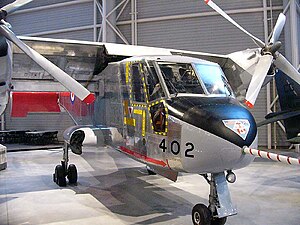A vertical take-off and landing (VTOL) aircraft is one that can hover, take off, and land vertically. This classification can include a variety of types of aircraft including fixed-wing aircraft as well as helicopters and other aircraft with powered rotors, such as cyclogyros/cyclocopters and tiltrotors. Some VTOL aircraft can operate in other modes as well, such as CTOL, STOL, or STOVL. Others, such as some helicopters, can only operate by VTOL, due to the aircraft lacking landing gear that can handle horizontal motion. VTOL is a subset of V/STOL. Some lighter-than-air aircraft also qualify as VTOL aircraft, as they can hover, takeoff, and land with vertical approach/departure profiles.

A tiltrotor is an aircraft which generates lift and propulsion by way of one or more powered rotors mounted on rotating shafts or nacelles usually at the ends of a fixed wing. Almost all tiltrotors use a transverse rotor design, with a few exceptions that use other multirotor layouts.
For fixed-wing aircraft, ground effect is the reduced aerodynamic drag that an aircraft's wings generate when they are close to a fixed surface. Reduced drag when in ground effect during takeoff can cause the aircraft to "float" whilst below the recommended climb speed. The pilot can then fly just above the runway while the aircraft accelerates in ground effect until a safe climb speed is reached.

A vertical and/or short take-off and landing (V/STOL) aircraft is an airplane able to take-off or land vertically or on short runways. Vertical takeoff and landing (VTOL) aircraft are a subset of V/STOL craft that do not require runways at all. Generally, a V/STOL aircraft needs to be able to hover. Helicopters are not considered under the V/STOL classification as the classification is only used for aeroplanes, aircraft that achieve lift (force) in forward flight by planing the air, thereby achieving speed and fuel efficiency that is typically greater than the capability of helicopters.

The Bell XV-15 is an American tiltrotor VTOL aircraft. It was the second successful experimental tiltrotor aircraft and the first to demonstrate the concept's high speed performance relative to conventional helicopters.
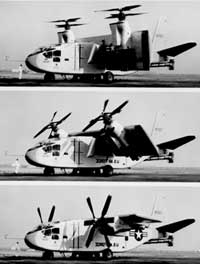
A tiltwing aircraft features a wing that is horizontal for conventional forward flight and rotates up for vertical takeoff and landing. It is similar to the tiltrotor design where only the propeller and engine rotate. Tiltwing aircraft are typically fully capable of VTOL operations.

The AgustaWestland AW609, formerly the Bell/Agusta BA609, is a twin-engined tiltrotor VTOL aircraft with a configuration similar to that of the Bell Boeing V-22 Osprey. It is capable of landing vertically like a helicopter while having a range and speed in excess of conventional rotorcraft. The AW609 is aimed at the civil aviation market, in particular VIP customers and offshore oil and gas operators.

The Bombardier Challenger 600 series is a family of business jets developed by Canadair after a Bill Lear concept, and then produced from 1986 by its new owner, Bombardier Aerospace. At the end of 1975, Canadair began funding the development of LearStar 600, and then bought the design for a wide-cabin business jet in April 1976. On 29 October, the programme was launched, backed by the Canadian federal government, and designed to comply with new FAR part 25 standards.

The Bell X-22 is an American V/STOL X-plane with four tilting ducted fans. Takeoff was to selectively occur either with the propellers tilted vertically upwards, or on a short runway with the nacelles tilted forward at approximately 45°. Additionally, the X-22 was to provide more insight into the tactical application of vertical takeoff troop transporters such as the preceding Hiller X-18 and the X-22's successor, the Bell XV-15. Another program requirement was a true airspeed in level flight of at least 525 km/h.
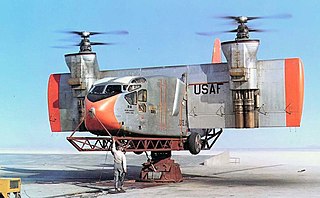
The Hiller X-18 was an experimental cargo transport aircraft designed to be the first testbed for tiltwing and V/STOL technology.
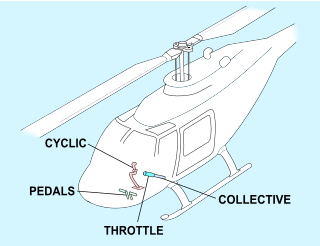
A helicopter pilot manipulates the helicopter flight controls to achieve and maintain controlled aerodynamic flight. Changes to the aircraft flight control system transmit mechanically to the rotor, producing aerodynamic effects on the rotor blades that make the helicopter move in a deliberate way. To tilt forward and back (pitch) or sideways (roll) requires that the controls alter the angle of attack of the main rotor blades cyclically during rotation, creating differing amounts of lift (force) at different points in the cycle. To increase or decrease overall lift requires that the controls alter the angle of attack for all blades collectively by equal amounts at the same time, resulting in ascent, descent, acceleration and deceleration.

The Canadair CL-44 was a Canadian turboprop airliner and cargo aircraft based on the Bristol Britannia that was developed and produced by Canadair in the late 1950s and early 1960s. Although innovative, only a small number of the aircraft were produced for the Royal Canadian Air Force (RCAF), and for commercial operators worldwide.

The Fairey Jet Gyrodyne is a British experimental compound autogyro built by the Fairey Aviation Company that incorporated helicopter, gyrodyne and autogyro characteristics. The Jet Gyrodyne was the subject of a Ministry of Supply (MoS) research contract to gather data for the follow-up design, the Rotodyne.

The Ling-Temco-Vought (LTV) XC-142 was a tri-service tiltwing experimental aircraft designed to investigate the operational suitability of vertical/short takeoff and landing (V/STOL) transports. An XC-142A first flew conventionally on 29 September 1964, and on 11 January 1965, it completed its first transitional flight by taking off vertically, changing to forward flight and finally landing vertically. Its service sponsors pulled out of the program one by one, and it eventually ended due to a lack of interest after demonstrating its capabilities successfully.
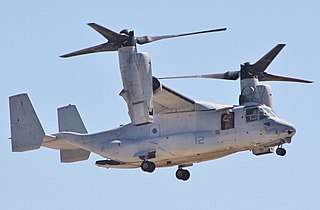
A powered lift aircraft takes offs and lands vertically under engine power but uses a fixed wing for horizontal flight. Like helicopters, these aircraft do not need a long runway to take off and land, but they have a speed and performance similar to standard fixed-wing aircraft in combat or other situations.

A proprotor is a spinning airfoil that function as both an airplane-style propeller and a helicopter-style rotor. Several proprotor-equipped convertiplanes, such as the Bell Boeing V-22 Osprey tiltrotor, are capable of switching back and forth between flying akin to both helicopters and fixed-wing aircraft. Accordingly this type of airfoil has been predominantly applied to vertical takeoff and landing (VTOL) aircraft.
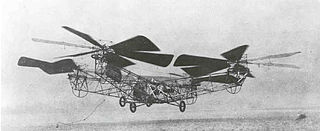
The de Bothezat helicopter, also known as the Jerome-de Bothezat Flying Octopus, was an experimental quadrotor helicopter built for the United States Army Air Service by George de Bothezat in the early 1920s, and was said at the time to be the first successful helicopter. Although its four massive six-bladed rotors allowed the craft to successfully fly, it suffered from complexity, control difficulties, and high pilot workload, and was reportedly only capable of forward flight in a favorable wind. The Army canceled the program in 1924, and the aircraft was scrapped.

The Dornier Do 29 was an experimental aircraft developed by Dornier Flugzeugwerke and the Deutsche Versuchsanstalt für Luftfahrt in the 1950s, used to test a tilting-propeller system for short takeoff and landing (STOL) aircraft. The concept was proved to be successful in flight testing; however, no further development of the system or aircraft was proceeded with, and at the conclusion of its test program the Do 29 was retired.

The GL-10 Greased Lightning is a hybrid diesel-electric tiltwing unmanned aircraft.
